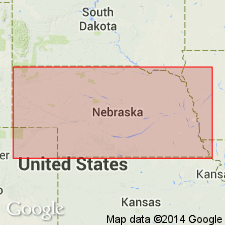
- Usage in publication:
-
- Kinney limestone member
- Modifications:
-
- Original reference
- Dominant lithology:
-
- Limestone
- Shale
- AAPG geologic province:
-
- Nemaha anticline
Summary:
Pg. 37. Kinney limestone. Middle member of Matfield formation of Chase group. Thickness 12 feet in Nebraska and 15 feet or more in southern Kansas, in vicinity of Burden. In Nebraska it consists of (descending): (1) two mudstone limestones, separated by shale, about 1 foot 8 inches; (2) gray shale, 5 or 6 feet; (3) gray limestone, 5 feet or more. In central and southern Kansas the lower limestone becomes prominent and massive and the upper zone becomes about 6 feet of very thin fossiliferous limestone beds spearated by shale seams, with 2 or 3 feet of limy shale remaining as zone 2. Underlies Blue Springs shale member and overlies Wyamore shale member. Fossils (brachiopods DERBYA, COMPOSITA, productids; mollusk MYALINA). Age is Permian (Big Blue).
Type locality: Burlington RR cut just east of Kinney, Gage Co., southeastern NE. Named from town of Kinney.
Source: US geologic names lexicon (USGS Bull. 896, p. 1102); GNC KS-NE Permian Corr. Chart, Oct. 1936; supplemental information from GNU records (USGS DDS-6; Denver GNULEX).
For more information, please contact Nancy Stamm, Geologic Names Committee Secretary.
Asterisk (*) indicates published by U.S. Geological Survey authors.
"No current usage" (†) implies that a name has been abandoned or has fallen into disuse. Former usage and, if known, replacement name given in parentheses ( ).
Slash (/) indicates name conflicts with nomenclatural guidelines (CSN, 1933; ACSN, 1961, 1970; NACSN, 1983, 2005, 2021). May be explained within brackets ([ ]).

